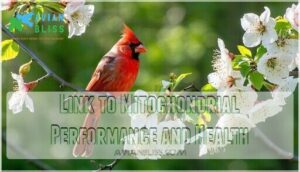This site is supported by our readers. We may earn a commission, at no cost to you, if you purchase through links.

Cardinals get their stunning red color from carotenoids—pigments found in berries, seeds, and fruits they eat.
Here’s the cool part: their bodies use an enzyme called ketolase to transform these yellow plant pigments into brilliant red ketocarotenoids.
It’s like having an internal paint mixer that turns ordinary ingredients into show-stopping crimson.
This vibrant red isn’t just for looks—it’s a male cardinal’s way of advertising his superior genes and health to potential mates.
The redder he is, the better his diet and genetic quality.
But there’s more to this colorful story than meets the eye.
Table Of Contents
- Key Takeaways
- Cardinal Red Color Origin
- Why Are Cardinals Red
- Red Feather Development Process
- Cardinal Red Color Significance
- Maintaining Cardinal Red Color
- Frequently Asked Questions (FAQs)
- Why did cardinals evolve to be red?
- Are cardinals naturally red?
- When you see a red cardinal in your yard?
- How rare is it to see a red cardinal?
- Why aren’t female cardinals red?
- What does it mean when a red cardinal?
- Why are Cardinals Red?
- What color are Cardinals?
- What makes a male Cardinal bright red?
- Do Cardinals change color?
- Conclusion
Key Takeaways
- You’ll see cardinals’ red color comes from carotenoids in their diet – berries, seeds, and fruits they eat get converted into brilliant red pigments by a special enzyme called ketolase in their bodies.
- Male cardinals use their bright red feathers as nature’s dating profile – the redder the male, the healthier his genes and the more attractive he is to female cardinals looking for quality mates.
- You can help maintain cardinals’ vibrant color by providing carotenoid-rich foods – offer sunflower seeds, safflower seeds, dried cranberries, and plant native berry bushes in your yard.
- Cardinals’ red plumage isn’t just pretty – it’s functional – males with brighter red feathers dominate territories, attract more mates, and even provide better parental care to their chicks.
Cardinal Red Color Origin
You’ve likely wondered why cardinals display such brilliant red feathers while most other birds sport more subdued colors.
This striking coloration results from a fascinating combination of diet, genetics, and evolutionary pressures that have shaped these birds over millions of years, which is a fascinating aspect of their development.
Millions of years of evolution crafted the cardinal’s brilliant red as nature’s perfect advertisement for genetic superiority.
Evolutionary Advantages of Red Plumage
You’ll find that cardinal bird color evolution favors red plumage because it offers surprising advantages beyond simple mating rituals.
While bright red might seem to increase bird visibility, predators can exploit, males actually gain vital benefits through species recognition and social signaling.
Red bird species like cardinals use their vibrant coloration for territorial dominance, accessing better resources and nesting sites while maintaining environmental adaptation.
This vibrant coloration is due to a gene that facilitates red pigment production.
Role of Carotenoids in Coloration
You’ll discover that carotenoids act like nature’s paintbrush for cardinal bird color.
Nature’s paintbrush transforms everyday berries into brilliant cardinal crimson through dietary magic.
These powerful pigments come from berries, seeds, and fruits that cardinals eat daily. Your backyard cardinal transforms these compounds into stunning red feathers through pigment deposition, where dietary impact directly controls color intensity and feather health.
- Carotenoid sources include dogwood berries, sumac fruits, and sunflower seeds that fuel vibrant plumage
- Pigment deposition occurs when birds metabolize yellow carotenoids into red pigments during molting cycles
- Color intensity depends on diet quality – well-fed cardinals display deeper, more brilliant red coloration
- Feather health improves with carotenoid-rich foods, creating stronger, more resilient plumage that lasts longer
Genetic Basis of Red Feather Coloration
Bird color genetics reveal fascinating mechanisms behind cardinal red plumage.
You’ll find that gene expression drives carotenoid synthesis through specific enzyme mutations in the red pigment pathway.
The CYP2J19 gene acts like nature’s artist, converting yellow carotenoids into vibrant red ketocarotenoids.
Genetic inheritance patterns show this avian coloration requires precise molecular choreography, making cardinals living examples of evolutionary artistry.
This conversion is facilitated by ketocarotenoid production within the bird’s system, which is a key aspect of avian coloration and involves evolutionary artistry.
Why Are Cardinals Red
You’ve likely wondered why male cardinals display such vibrant red feathers while females remain a more subdued brown.
This striking red coloration serves as nature’s advertisement for genetic quality, signaling to potential mates that the male possesses superior genes and excellent health.
Significance of Red Color in Mate Attraction
You’ll notice something remarkable during breeding season: female cardinals show strong female preference for males with the most vibrant red plumage.
This mate selection isn’t random – intense red intensity signals superior health and genetic quality.
Females can distinguish subtle differences in red coloration, making color perception essential for breeding success.
- Red intensity directly correlates with a male’s ability to attract multiple mates
- Brighter red cardinals secure better territories and nesting sites
- Female cardinals spend more time evaluating males with deeper red hues
Indication of Superior Genes and Fitness
Cardinal red plumage serves as nature’s billboard for genetic superiority.
Males with vibrant red feathers demonstrate strong genetic predisposition and fitness correlation, signaling exceptional survival advantage to potential mates.
This brilliant bird plumage color indicates superior offspring quality through heritability traits.
Females instinctively recognize that redder males possess better genes, ensuring healthier chicks with enhanced survival prospects in demanding environments, which is a result of the genetic superiority.
Link to Mitochondrial Performance and Health
Red feathers reveal your cardinal’s cellular powerhouse at work.
Brighter red coloration directly correlates with superior mitochondrial function, indicating healthier energy production and reduced oxidative stress in cells.
Here’s how mitochondrial performance affects bird plumage colors:
- Cellular Energy Production – Efficient mitochondria power the conversion of dietary carotenoids into vibrant red pigments
- Oxidative Stress Management – Healthy mitochondria reduce cellular damage, allowing natural pigments birds produce to shine through
- Genetic Health Expression – Superior mitochondrial genes enable complete carotenoid metabolism for intense red bird feather color
- Diet Impact Processing – Well-functioning mitochondria maximize carotenoids in birds from their food sources
Red Feather Development Process
You’ll discover how cardinals develop their stunning red feathers through a fascinating biological process that depends on their diet and special enzymes.
The transformation happens during molting when new feathers grow, but the brilliant red color only appears if the bird consumes enough carotenoid-rich foods and produces the right enzymes to convert these pigments, which is a crucial step for the brilliant red color to appear.
Molting and Feather Growth
When autumn arrives, cardinals undergo their annual molt, shedding worn feathers for fresh plumage.
This molting frequency occurs once yearly, with new feathers requiring significant energy expenditure during growth.
Each feather’s composition rebuilds from scratch, allowing seasonal changes in bird plumage colors.
The growth rate varies by feather type, but carotenoids in birds must be actively deposited during development.
Without proper bird diet color sources, natural pigments birds produce won’t achieve that brilliant red bird feather color we admire.
Diet and Carotenoid Intake
You’ve probably wondered what makes a cardinal’s red so vibrant.
Their diet holds the key to this stunning display, as cardinals can’t produce carotenoids themselves, so they must consume them through food sources like berries, seeds, and insects.
These pigments from their meals directly impact feather coloration.
During winter, when carotenoid sources become scarce, maintaining proper nutrition becomes challenging, affecting future plumage brightness and overall bird health.
Enzyme Ketolase and Red Pigment Production
After carotenoids enter a bird’s system, the enzyme ketolase (specifically CYP2J19) works its magic.
This specialized enzyme converts yellow dietary carotenoids into brilliant red ketocarotenoids through oxidation. The ketolase function adds oxygen atoms to carotenoid molecules, triggering pigment synthesis and carotenoid conversion.
Enzyme regulation determines red intensification levels, directly linking diet quality to the stunning color pigmentation you see in cardinal feathers.
Diet also plays a pivotal role in the expression of vibrant carotenoid colors, which is a key factor in the development of brilliant red ketocarotenoids.
Cardinal Red Color Significance
A cardinal’s bright red feathers serve as nature’s billboard, advertising his health and genetic quality to potential mates and rivals.
You’ll notice that the reddest males often dominate territories and attract the most females, proving that in the bird world, being red really does mean being ready to succeed.
Social Cue and Dominance Indicator
When you spot a bright red cardinal, you’re witnessing nature’s power display in action.
Red Dominance signals a bird’s position in the Social Hierarchy, with deeper crimson feathers indicating higher rank.
This Competition Indicator helps establish Territory Defense boundaries, as rival males recognize superior opponents.
Female Preference often favors these vibrant displays, making bird color symbolism essential for survival among common red birds throughout their hierarchy.
Mating Advantage and Reproductive Success
In the context of mating success, redder cardinals win big in the breeding game.
Female preference drives this advantage—females consistently choose males with vibrant red plumage over duller competitors.
This choice isn’t random; bright red signals superior genetic diversity and enhanced offspring survival rates.
Redder males also excel at territory defense, securing prime nesting spots that boost breeding frequency and protect their families from predators.
Increased Parental Care by Redder Males
You’ll find that redder male cardinals don’t just look impressive – they’re better dads too.
These vibrant males provide superior parental care, directly boosting chick survival rates through their dedication.
Research shows brighter males excel in four key areas:
- Higher feeding frequency to nestlings throughout the day
- Enhanced territory defense against predators and competitors
- Better nestling health outcomes due to consistent provisioning
- Improved nest success rates compared to duller males
This male coloration advantage explains why birds are colorful – it signals quality parenting skills that females actively seek during bird mating rituals.
Males show off their vibrant crimson plumage, while females have muted colors.
Maintaining Cardinal Red Color
You can support a cardinal’s vibrant red coloration by providing carotenoid-rich foods like sunflower seeds, safflower seeds, and native berries throughout the year.
A diverse diet that includes insects, fruits from dogwood and elderberry plants, and quality bird seed guarantees cardinals get the nutrients they need to maintain their brilliant plumage.
Planting Native Fruit Trees and Bushes
You can support attracting Cardinals by establishing native fruit trees and bushes in your yard.
Local nurseries offer berry varieties like elderberry, dogwood, and sumac that provide natural bird food sources.
Proper soil preparation guarantees healthy growth, while winter protection helps plants survive harsh weather.
These native plants create ideal bird habitat color schemes, offering both food and shelter that types of red birds need year-round.
Many gardeners find success purchasing fruit tree products online.
Providing Carotenoid-Rich Foods
You can boost Food Availability by offering carotenoid-rich treats like dried cranberries, paprika, or chopped carrots.
While Wild Sources provide natural nutrition, Supplementing Diet with these foods helps maintain vibrant plumage.
Garden Options include planting berry bushes nearby. Some bird enthusiasts also purchase dried cranberries to supplement their diets.
During Winter Feeding, when natural bird food sources become scarce, these supplements become especially important for types of red birds maintaining their striking bird habitat color.
Importance of Varied Diet for Cardinals
Cardinals need dietary diversity beyond carotenoid sources for ideal health benefits.
Their foraging behavior naturally seeks varied bird food sources including seeds, fruits, and insects.
Nutritional deficiencies from limited diets can affect their vibrant red coloration and overall fitness.
Cardinals particularly enjoy black oil sunflower seeds.
While bright plumage increases bird visibility to predators, healthy cardinals in proper bird habitat color environments thrive when their diet supports the cardinal virtues of strength and vitality.
Frequently Asked Questions (FAQs)
Why did cardinals evolve to be red?
Looking at nature’s most stunning display, you’d wonder what drives such vibrant coloration.
Male cardinals evolved brilliant red feathers through sexual selection – females consistently choose the reddest mates because intense coloring signals superior health, genetic quality, and ability to find carotenoid-rich foods.
Are cardinals naturally red?
Yes, male cardinals are naturally red through genetic processes that convert yellow carotenoids from their diet into red pigments using an enzyme called ketolase.
Without this natural ability, they’d stay yellow like rare mutant cardinals, highlighting the importance of this process in their appearance.
When you see a red cardinal in your yard?
Your heart practically skips a beat when that brilliant crimson flash catches your eye.
You’re witnessing nature’s stunning masterpiece – a male cardinal flaunting his vibrant red plumage that’s designed to attract mates and signal his dominance in the territory.
How rare is it to see a red cardinal?
You’ll find red cardinals fairly easily in most backyards across their range. They’re a perfect combination of familiarity, conspicuousness, and style, making them common year-round residents rather than rare sightings.
Why aren’t female cardinals red?
Female cardinals aren’t red because they need camouflage while nesting.
Their brown and tan feathers help them blend into bushes and trees, protecting both them and their eggs from predators lurking nearby.
What does it mean when a red cardinal?
Like a vibrant flash against winter’s gray canvas, you’ll spot a red cardinal carrying spiritual messages of faith, divine guidance, and comfort from loved ones who’ve passed away.
Many believe cardinals bridge earthly and heavenly domains, serving as a symbol of divine guidance.
Why are Cardinals Red?
Cardinals get their red color from carotenoid pigments in their diet.
You’ll see males sporting bright red feathers because they eat berries, seeds, and insects containing these natural compounds that enhance their vibrant appearance for attracting mates.
What color are Cardinals?
You’ll spot male cardinals displaying brilliant red plumage year-round, while females show warm brown feathers with subtle red tinges on wings, tail, and crest for camouflage.
What makes a male Cardinal bright red?
You’ll notice male cardinals sport their stunning red plumage thanks to carotenoid pigments they consume from berries, seeds, and insects.
Their diet directly fuels this vibrant coloration that attracts mates during breeding season, showcasing the importance of diet in their appearance.
Do Cardinals change color?
You’ll see cardinals undergo seasonal color changes, especially males. Their brilliant red feathers fade to duller shades during fall molt, then brighten again in spring for mating season.
Conclusion
Nearly 95% of male cardinals maintain their vibrant red plumage year-round, making them one of nature’s most consistent colorful displays.
Understanding why are cardinals red reveals a fascinating biological process where diet directly transforms appearance. These crimson feathers aren’t just beautiful—they’re powerful advertisements of genetic quality and health.
You’ve learned how carotenoids from berries and seeds become brilliant red ketocarotenoids through specialized enzymes. This color-coding system helps females choose the fittest mates, ensuring stronger offspring and species survival through nature’s remarkable visual language.
This process ultimately ensures species survival through the selection of the fittest mates, highlighting the intricate and beautiful mechanisms of nature.
- https://docs.google.com/forms/d/1GAQr3Kn1cURCVHUA82hAga1Wv8DCH0IuqDLRUrOpN7M/viewform?ts=63f4f653&entry.1515682415=https://www.merriam-webster.com/dictionary%2Fwhy
- https://premium.britannica.com/mw-unabridged/?utm_source=mw&utm_medium=inline-def&utm_campaign=evergreen
- https://blog.collinsdictionary.com/cefr-labels-explained/
- https://grammar.collinsdictionary.com/easy-learning/the-interrogative-and-wh-words
- https://dictionary.cambridge.org/dictionary/english/amirite?topic=question-words-and-expressions












